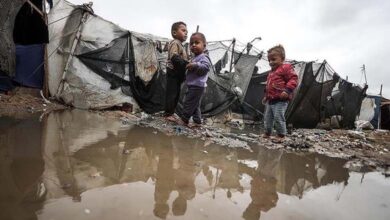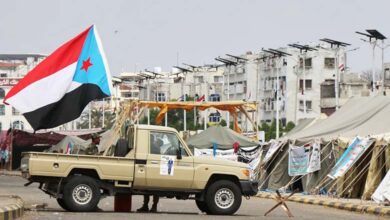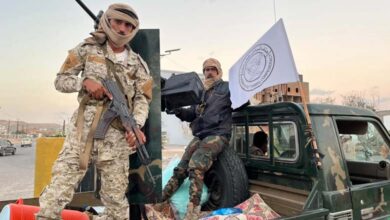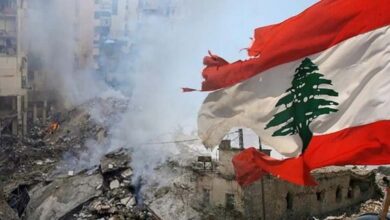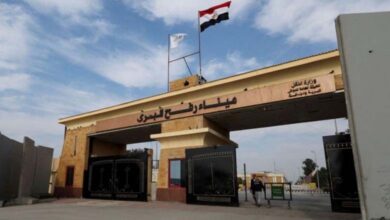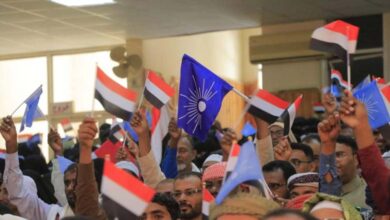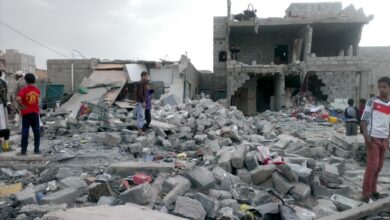2 Million Palestinians in 15% of Gaza’s Area… 36,000 People per Square Kilometer
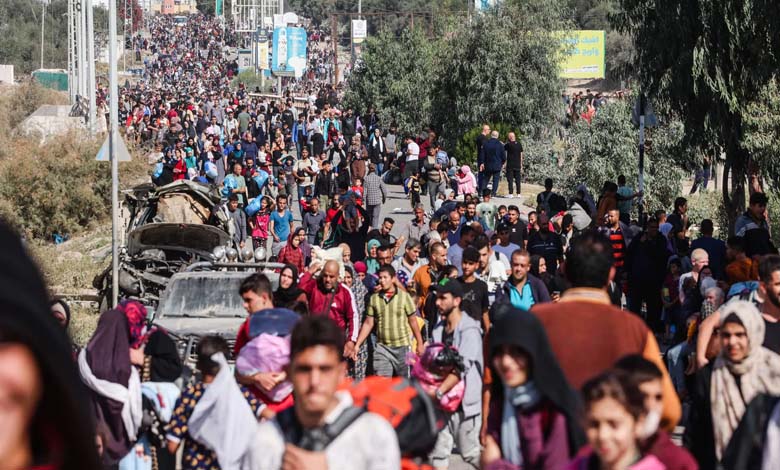
More than 2 million Palestinians now live on only 15% of Gaza’s total area, reflecting the current reality of the territory.
The total area of the Gaza Strip is about 365 km², meaning roughly 55 km² are available for the entire population, or approximately 36,000 people per square kilometer.
-
Palestinian Political Analyst: The Occupation is Deliberately Strangling Gaza… and the International Community Fails to Act
-
Gaza Latest: Evacuation Orders in the North and Humanitarian Ship Intercepted at Sea
The Israeli army stated on Friday that it “currently operationally controls about 65% of the Gaza Strip’s area.”
However, the United Nations says the area classified by the Israeli army as a high-risk combat zone reaches 85% of Gaza’s territory.
Some Palestinians still refuse to leave the dangerous areas.
The United Nations Office for the Coordination of Humanitarian Affairs (OCHA) reported, in a statement received Friday, that “as of July 2, 85 percent of Gaza’s land lies within Israeli military zones or is subject to evacuation orders that largely overlap.”
-
Gaza Latest: 31 Killed by Israeli Fire Near Aid Center
-
Café altercation puts France on alert – Gaza war echoes in Paris suburbs
Between June 25 and July 2, the Israeli army issued three evacuation orders covering areas in the Khan Younis, Deir al-Balah, northern Gaza, and Gaza governorates, totaling 14.4 km².
The report states that approximately 28,660 people were displaced between June 29 and 30.
Since March 18, the Israeli army has issued 50 evacuation orders, subjecting about 282.4 km², or 78% of Gaza’s area, to displacement directives.
-
Gaza Foundation: Potential U.S. Funding Could Entangle Washington in Aid Chaos
-
Arming and Funding… Is Israel Repeating the Lahad Army Experience in Gaza?
One-Third of Gaza’s Population Displaced in Three Months
According to OCHA, more than 714,000 people, or one-third of Gaza’s population, have been displaced over the past three months.
These figures do not include an evacuation order issued on Friday covering the Khan Younis city area, which further limits where Palestinians can remain.
Where Do Palestinians Go?
OCHA points out that with no safe places left, many have sought shelter in overcrowded sites, temporary shelters, damaged buildings, streets, and open spaces—confined to shrinking areas.
-
U.S. Veto Blocks Ceasefire Efforts in Gaza
-
Latest Gaza News: 15 Killed While Waiting for Aid, Israel Acknowledges Incident
Although the Israeli army instructs residents to move to the “Al-Mawasi” area west of Khan Younis, designated as a humanitarian safe zone, reports indicate it is not truly safe.
The Israeli military continues intensive attacks in Al-Mawasi, directly targeting temporary tents, killing entire families, even as it orders Palestinians elsewhere in Gaza to relocate to “known shelter centers” in Al-Mawasi.
The population of Al-Mawasi—about 9 km²—has tripled in three months, rising from roughly 115,000 to over 425,000 due to ongoing evacuation orders and escalating military operations in Rafah and Khan Younis.
-
Palestinian Political Analyst: The Occupation Is Deliberately Starving Gaza’s Children to Break the People’s Resilience
-
Gaza… The Hungriest Place on Earth
Population density there is currently estimated at 48,000 people per km², nearly all living in very rudimentary tents.
Between March 18 and June 16, 2025, the UN Human Rights Office recorded 112 attacks on Al-Mawasi, killing 380 people, including at least 158 women and children.
Between June 26 and July 1, at least ten schools sheltering displaced persons were bombed, including two that had been warned in advance.
These attacks resulted in at least 29 deaths, injuries, and displacement of dozens of families, many of whom returned to some damaged schools due to lack of alternative shelter.
-
Hunger Precedes Aid: Food Warehouse Stormed in Gaza Amid Humanitarian Collapse
-
After the Chaos of the First Distribution… Will the New Aid Mechanism in Gaza Hold?
Attacks During Food Collection
The UN reports that large numbers of casualties continue daily over the past five weeks as people approach militarized aid distribution sites or wait on roads designated by Israeli authorities for aid convoys.
On July 1, Gaza’s Ministry of Health reported 583 deaths between May 27 and June 28, including 16% children, 2% women, and 2% elderly. This includes 408 deaths related to militarized distribution sites and 175 killed while waiting for aid convoys.
-
Did the Gaza Truce Falter Over a Handshake? Details of the Rejected Proposal
-
Gaza Aid: Sudden Resignation of Director of the New Mechanism
Imminent Collapse of Humanitarian Operations
The UN warns of an imminent collapse of humanitarian operations if fuel supplies to Gaza are not restored.
All fuel recovered from local reserves has been allocated to partner humanitarian organizations, meaning no fuel is currently available for distribution.
This threatens life-saving services including health, water, sanitation, communications, protection, and food delivery and distribution, increasing the risk of famine.
-
War in Gaza: Intensified Israeli Strikes and Rocket Response
-
U.S.-Backed Gaza Aid Plan Rejected by the United Nations
Impact on Negotiations?
Israel states that the war ongoing since October 7, 2023, especially since March 18, aims to pressure Hamas to release Israeli hostages.
Israeli estimates suggest that pressuring Gaza’s population by shrinking their living areas will push residents to pressure Hamas to accept prisoner exchange proposals and a ceasefire.
Reports indicate growing pressure from Gaza residents on Hamas to accept the offer, even if not all demands are met, to end hostilities.
-
“Enough”: A Palestinian Cry from Gaza
-
Israeli escalation on Gaza 33 Palestinians killed including children in overnight airstrikes
If a ceasefire is implemented, the Israeli army would withdraw from large parts of Gaza, allow humanitarian aid entry, and cease air, land, and sea attacks.
Since the recent announcement of a possible agreement, Israeli attacks across Gaza have surged unprecedentedly.
The Israeli army reported operations by several divisions across Gaza, supported by air strikes on about 100 targets, including launch sites, military buildings, and weapons depots.
This military buildup is nearly unprecedented in over a year.
-
Political Analyst: Gaza Faces a Slow Death Amid Disgraceful International Silence
-
Land Sea and Air… Israel Prepares for an Unprecedente Incursion into Gaza
Meanwhile, Palestinian deaths exceed 100 daily, and Israeli casualties have also risen noticeably.
On Friday, the Israeli army announced the death of soldier Asaf Zamir in Khan Younis during an operation. He was reportedly killed by an anti-tank missile, with serious injuries to comrades and an officer.
Earlier that day, soldier Yair Eliyahu (19) died after his engineering vehicle fell into a hole during a military operation in northern Gaza.
Since the conflict began, the Israeli army reports 883 soldiers killed and 6,032 wounded, including 439 and 2,745 respectively on Gaza’s ground.
-
Mass Displacement and Annexation Threats: The West Bank Faces a Gaza Scenario
-
We Don’t Want to Hear the Word Evacuation: Gaza Voices Stand Against Displacement Plans
These losses increase pressure on the Israeli government to reach an agreement.
Einav Tsengauker, mother of hostage soldier Matan, appealed: “Too many victims have fallen, too many soldiers have died in this Gaza war. We must stop this. We do not want to see more families engulfed in grief. Let’s save the living hostages and bring home the dead before they disappear forever.”
At a rally in front of the U.S. embassy on American Independence Day, before the Trump–Netanyahu meeting in Washington, she added: “After Lebanon and Iran, it is time to close the Gaza file. Bring Matan and all the hostages home, end the war.”
She concluded: “Dear President Trump, we count on you to free all fifty hostages and end the war, and we ask you to continue pressing—with your voice and your power—for a comprehensive agreement that reunites all hostage families with their loved ones.”


